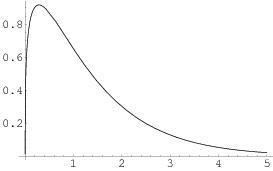 | ||
In mathematics the synchrotron functions are defined as follows (for x ≥ 0):
where Kj is the modified Bessel function of the second kind. The function F(x) is shown on the right, as the output from a plot in Mathematica.
Use in Astrophysics
In astrophysics, x is usually a ratio of frequencies, that is, the frequency over a critical frequency (critical frequency is the frequency at which most synchrotron radiation is radiated). This is needed when calculating the spectra for different types of synchrotron emission. It takes a spectrum of electrons (or any charged particle) generated by a separate process (such as a power law distribution of electrons and positrons from a constant injection spectrum) and converts this to the spectrum of photons generated by the input electrons/positrons.
For further information, see High Energy Astrophysics, Malcolm S. Longair, CUP, 1990.
